YouTube series “Navigating Digital Misinformation” teaches teens to be MediaWise
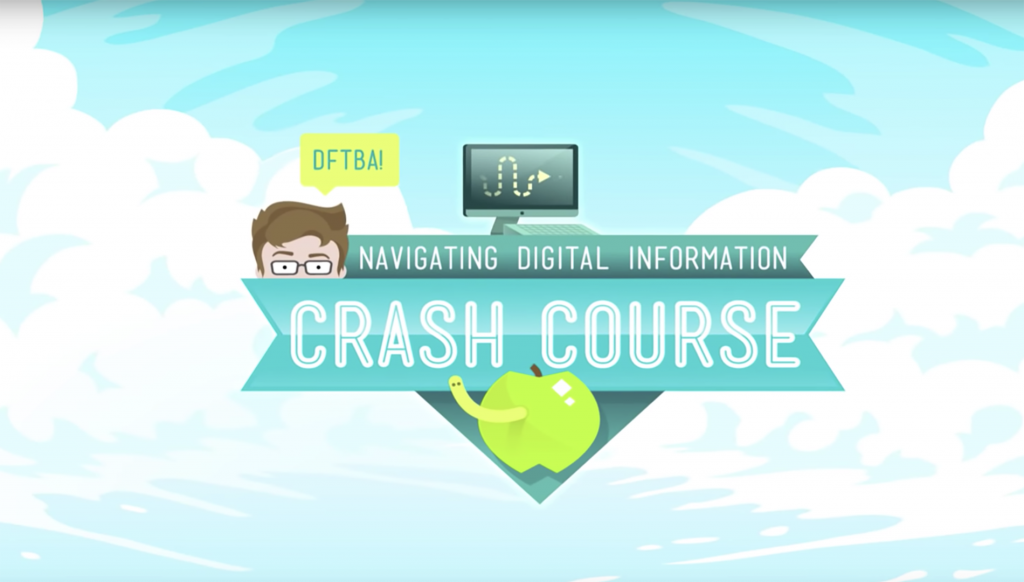
Teens on the internet are susceptible to online misinformation. That’s why MediaWise is teaming up with social media influencers — and famous journalists like Lester Holt, its first national ambassador — to teach media literacy skills.
MediaWise is a non-profit project by the Poynter Institute, Local Media Association (LMA) and the National Association for Media Literacy Education (NAMLE). Funded by Google, this project is part of the Google News Initiative and is based on news literacy curriculum by Stanford History Education Group (SHEG).
Designed to educate teens, MediaWise uses various influencers to portray media literacy in an approachable, relatable way. One influencer is Ingrid Nilsen, a YouTuber with 3.7 million subscribers who joined the MediaWise Teen Vogue Summit, teaching over 500 teens in the audience fact-checking skills.
MediaWise recently teamed up with Crash Course, a popular educational channel on YouTube, to create a video series that teaches teens how to navigate the tricky world of online information. Best-selling young adult author John Green hosts the series “Navigating Digital Misinformation,” which will have 10 episodes in total:
- Introduction
- Fact-checking
- Lateral Reading
- Deciding Who to Trust
- Using Wikipedia
- Evaluating Evidence
- Evaluating Photos and Videos
- Data and Infographics
- Click Restraint
- Social Media
Here are some initial thoughts from the first half of the series.
Overall
Host Green establishes transparency by explaining what MediaWise is, where it came from, and how “Navigating Digital Information” came to be.
Through vivid animations, engaging graphics and colorful data sets, he explains why it’s so important to identify and resist false or misleading information, even though it can be difficult at times. His sarcastic sense of humor and thorough explanations make the information easy to swallow.
When bringing up new topics, such as the supposed ubiquitousness of the internet, he stops himself to address different perspectives, such as the fact that internet access can be a barrier between people. Throughout the series, Green will stop to provide valuable insights that may not be immediately evident, making sure that his viewers gain a robust understanding of the digital world.
Video 1: Introduction to Online Information
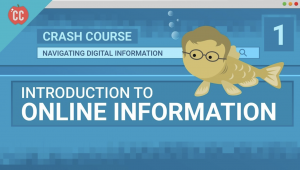 This first episode introduces digital news, media literacy and the many ways the internet can be used as a tool to manipulate people with misleading information. This 15-minute overview is framed through a joke about fish not understanding the water they swim in, which Green relates to people not fully understanding the digital world they swim in.
This first episode introduces digital news, media literacy and the many ways the internet can be used as a tool to manipulate people with misleading information. This 15-minute overview is framed through a joke about fish not understanding the water they swim in, which Green relates to people not fully understanding the digital world they swim in.
Key takeaway: Since information we take in shapes our beliefs, “It’s our job to analyze the information that we receive, find out where it falls on that spectrum [of authenticity], and decide how to use it going forward.”
Video 2: The Facts about Fact Checking
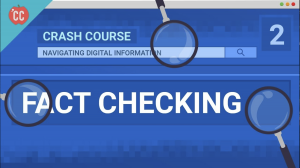 Green examines a SHEG research study, which asked different groups to judge the credibility of different websites. SHEG found fact-checkers were the most likely group to properly discern credibility, and Green explains what this group did that made them the most successful: They based their analysis of the site’s credibility on content, rather than presentation.
Green examines a SHEG research study, which asked different groups to judge the credibility of different websites. SHEG found fact-checkers were the most likely group to properly discern credibility, and Green explains what this group did that made them the most successful: They based their analysis of the site’s credibility on content, rather than presentation.
Key takeaway: When fact-checking information you find on the internet, ask yourself these three questions:
- Who is behind this information?
- What is the evidence for their claims?
- What is the source of their evidence?
Video 3: Lateral Reading
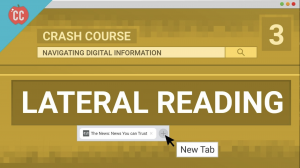 This video tackles lateral reading, using multiple tags for fact-checking while reading an article. Green gives an overview of where information comes from and why motives are important when deciding whether given information is reliable or not. The first question: Who made this and why?
This video tackles lateral reading, using multiple tags for fact-checking while reading an article. Green gives an overview of where information comes from and why motives are important when deciding whether given information is reliable or not. The first question: Who made this and why?
Lateral reading helps to keep a reader educated because they can find key information that isn’t immediately clear from the website they are learning from.
Key takeaway: First, there’s no “The media.” It’s a diverse industry full of different viewpoints, which you should take into account when reading laterally. Second, information is made by people, who have their own inherent bias. Third, Green says passively scrolling through your news feed and accepting what you read as fact has a negative effect. “Reading that way gives misinformation and disinformation more power. It allows people to hijack your consciousness, and it also makes you part of the problem.”
Videos 4: Deciding Who to Trust
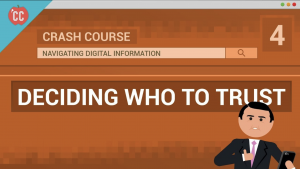 Green connects this video to the previous video on lateral reading to focus on one specific aspect of fact-checking: researching whether or not the author of a given source of information is reliable. Green explains also how even reputable sources, such as ProPublica, can make mistakes, and how important corrections are. Bias is another issue that’s tackled, and Green emphasizes that when screening sources, try to look for their perspective, rather than immediately dismissing their information due to your belief that they have a bias.
Green connects this video to the previous video on lateral reading to focus on one specific aspect of fact-checking: researching whether or not the author of a given source of information is reliable. Green explains also how even reputable sources, such as ProPublica, can make mistakes, and how important corrections are. Bias is another issue that’s tackled, and Green emphasizes that when screening sources, try to look for their perspective, rather than immediately dismissing their information due to your belief that they have a bias.
Key takeaway: Three indicators of whether a source is reputable are the author’s professional background, the process they used to produce that information, and the systems that are in place to catch mistakes and correct them. “You need to leave a source to understand it,” Green says, highlighting the importance of verifying a source’s credibility by doing outside research.
Video 5: Using Wikipedia
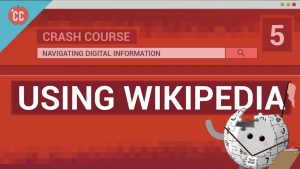 While Wikipedia is often dismissed as unreliable, Green argues that it is a valuable tool for lateral reading, gaining an overall view of a topic, and finding trustworthy sources from its references section. Green provides a non-judgmental, comprehensive overview of Wikipedia’s content policies, which include neutrality and verifiability. Green says Wikipedia should not be used as a one-stop shop for conducting in-depth research or for a source to be cited.
While Wikipedia is often dismissed as unreliable, Green argues that it is a valuable tool for lateral reading, gaining an overall view of a topic, and finding trustworthy sources from its references section. Green provides a non-judgmental, comprehensive overview of Wikipedia’s content policies, which include neutrality and verifiability. Green says Wikipedia should not be used as a one-stop shop for conducting in-depth research or for a source to be cited.
Key takeaway: There is no one perfect or objective source, and while Wikipedia is not by itself a good source to cite, it’s a powerful starting point.
Our Takeaway
Although the full series hasn’t been uploaded yet, the first video has 128,000 views as of Feb. 21. The audience seems to enjoy it, judging from the enthusiastic comment section and overall engagement. While the videos were information-heavy, they were colorful and engaging, which I found very helpful.
However, it may be hard for teens younger than 15 to digest the information load despite the jokes and graphics. Even with the best effort of Green and the animators, the topics are still pretty complicated and the longer episodes may be difficult for students in their early teens to pay attention to. Although Green’s ability to cover every detail of a topic helps foster a robust understanding, it could also distract viewers or lead to them clicking away.
